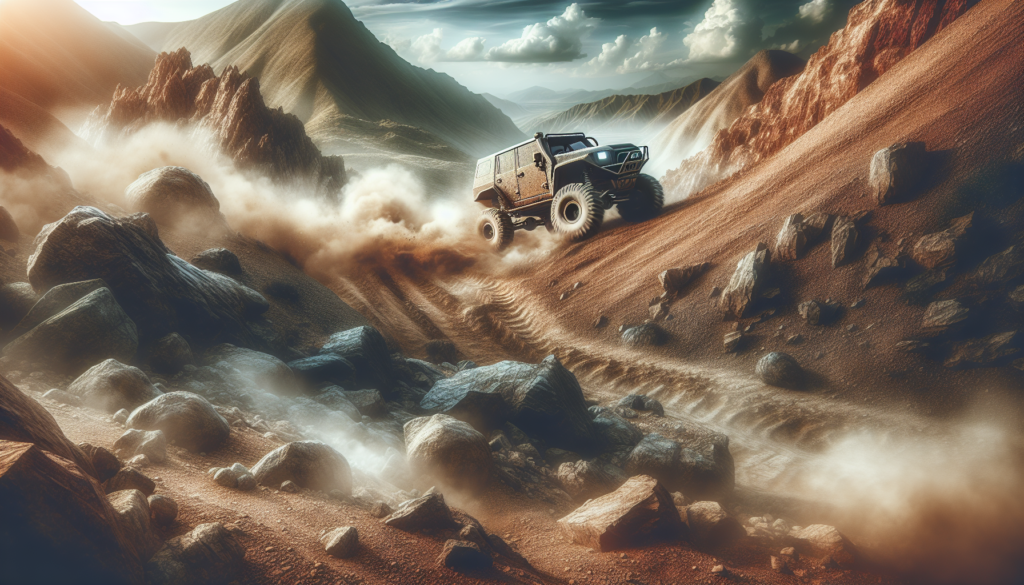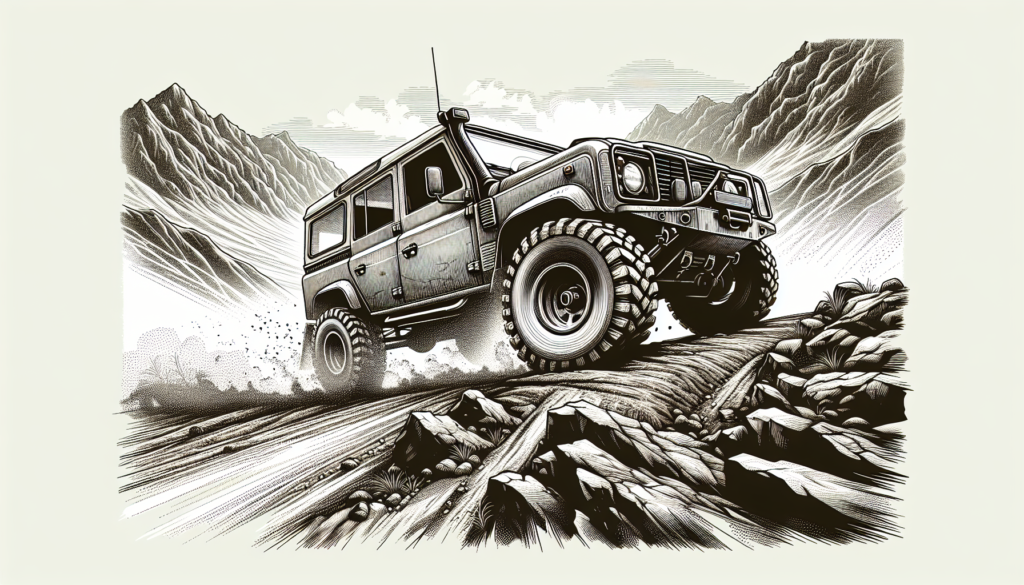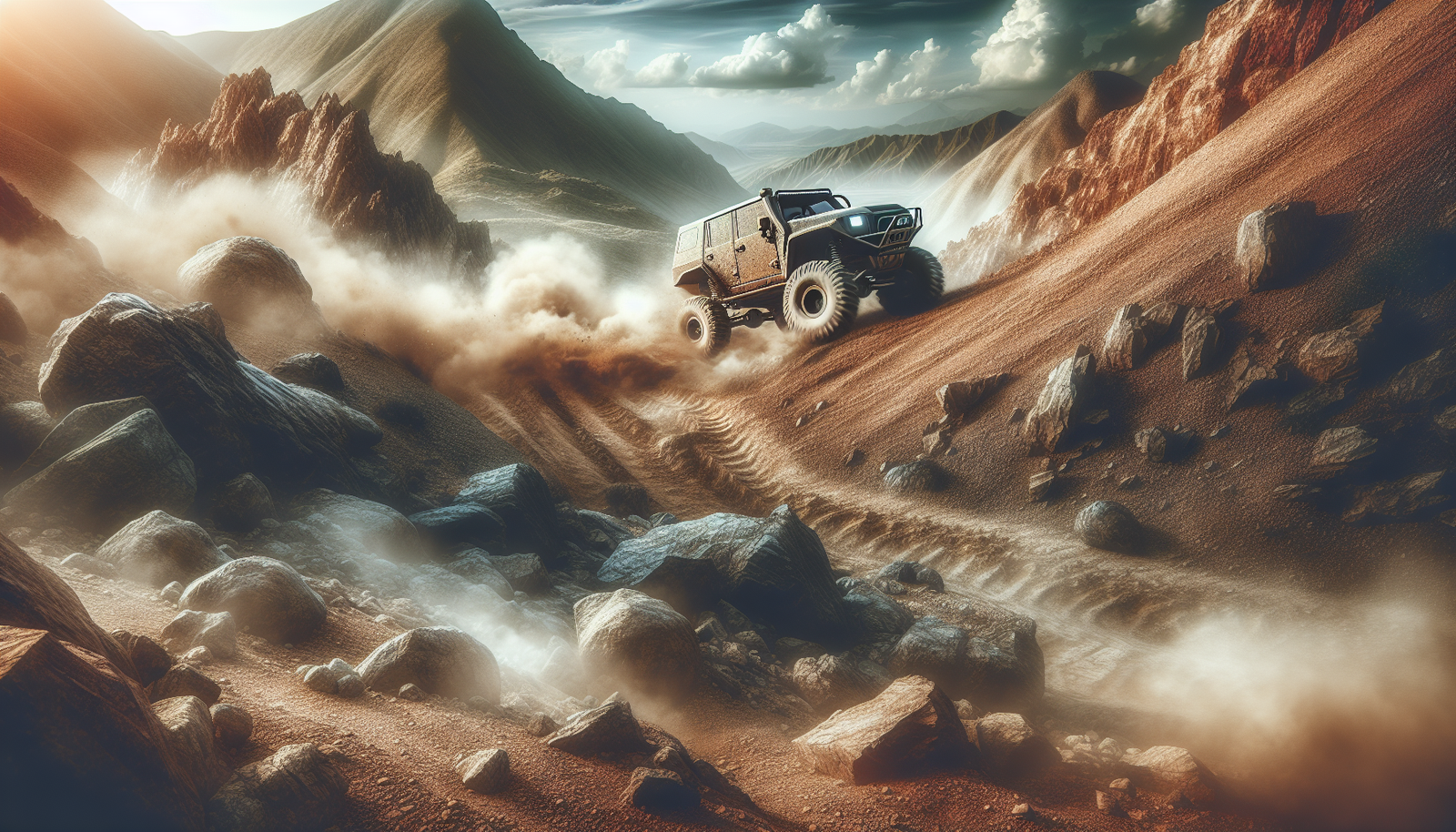Imagine you’re driving along, seeking the thrill and adventure of exploring off-road terrain. But as you leave the comfort of paved roads behind, uncertainty starts to creep in. How do you navigate through rough and unpredictable landscapes with confidence? In this article, we will guide you through the fundamental strategies and essential tips to ensure a safe and exciting off-road journey. From understanding tire pressure and terrain assessment to mastering the use of four-wheel drive, get ready to conquer the great outdoors like a seasoned off-road enthusiast.

Choosing the Right Vehicle for Off-roading
Off-roading can be an exhilarating and adventurous activity, but it’s essential to choose the right vehicle to ensure a safe and enjoyable experience. When selecting an off-road vehicle, there are several considerations to keep in mind.
Considerations for selecting an off-road vehicle
First and foremost, you need to determine the purpose of your off-roading adventures. Are you planning to tackle challenging rock trails or navigate through muddy terrain? Understanding the type of off-roading you intend to do will help narrow down your vehicle options.
Next, consider the size and weight of the vehicle. Smaller and lighter vehicles tend to be more agile and maneuverable, making them suitable for tight trails and rocky terrains. On the other hand, larger vehicles provide more space for gear and passengers, which can be advantageous for longer trips.
Another crucial factor is ground clearance. Off-road vehicles should have sufficient ground clearance to clear obstacles without getting stuck. It is also advisable to consider vehicles with robust suspension systems that can handle rough and uneven terrain.
Different types of off-road vehicles
There are various types of off-road vehicles available, each with its unique characteristics. Here is a brief overview of some popular options:
- SUVs: Sport Utility Vehicles are a common choice for off-roading due to their versatility. They offer a blend of off-road capabilities and on-road comfort.
- Trucks: Trucks are known for their payload capacity and towing capabilities. They are well-suited for hauling gear and equipment during off-road adventures.
- ATVs and UTVs: All-Terrain Vehicles (ATVs) and Utility Task Vehicles (UTVs) are compact and agile, designed specifically for off-road use. They excel in navigating narrow trails and rough terrains.
- Jeeps: Jeeps have a strong off-roading pedigree, known for their durability and four-wheel drive capabilities. They are often the vehicle of choice for serious off-roaders.
Features to look for in an off-road vehicle
When examining potential off-road vehicles, there are several features worth considering. Look for a four-wheel drive or all-wheel drive system, as this provides better traction and control in challenging conditions. Additionally, locking differentials and low-range gearing can enhance the vehicle’s ability to tackle steep inclines and slippery surfaces.
Off-road vehicles with skid plates and robust undercarriage protection are better equipped to handle rocks and other obstacles without sustaining damage. It is also beneficial to have ample cargo space, either within the vehicle or through the use of roof racks, to carry necessary equipment and supplies.
Furthermore, consider the availability of aftermarket accessories and modifications for the vehicle model you choose. These can enhance its off-road capabilities and allow for customization to meet your specific needs.
Understanding Off-road Terrain
Before embarking on any off-roading adventure, it is crucial to thoroughly understand the terrain you’ll be navigating. Researching and documenting off-road routes, identifying different types of terrains, and analyzing topography and features are fundamental aspects of successful off-road exploration.
Researching and documenting off-road routes
Start by researching established off-road trails and routes in the area you plan to explore. Look for reliable sources of information such as local off-roading clubs, forums, and online maps. These resources often provide valuable insights into the difficulty level, local regulations, and any notable challenges or attractions along the route.
Once you have identified potential routes, document them by creating detailed maps or using navigation tools. Note the critical landmarks, areas of potential difficulty, and any alternative routes or exits. Having a well-documented plan will help you navigate with ease and provide crucial information in case of an emergency.
Identifying different types of off-road terrains
Off-road terrains can vary significantly, and understanding their characteristics is essential as it dictates the approach and techniques required to navigate them safely. Some common types of off-road terrains include:
- Rocky trails: These terrains feature uneven surfaces with large rocks and boulders. Vehicle control, tire placement, and ground clearance are critical.
- Muddy terrain: Muddy trails pose traction challenges due to the slippery nature of the surface. Proper throttle control and tire selection are necessary to avoid getting stuck.
- Sand and dunes: Driving on sandy surfaces requires special techniques, as the sand can bog down vehicles and compromise traction.
- Rough terrain: This includes challenging landscapes with uneven ground, deep ruts, and obstacles. Slow and steady driving, along with advanced techniques, are crucial.
- Water crossings: Crossing bodies of water requires specific preparations and knowledge to prevent damage to the vehicle’s mechanical components.
Analyzing the topography and features of the terrain
Once you have identified the types of terrains you may encounter, analyze the topography and features of those terrains. Take note of any elevations, hills, valleys, or steep slopes that could pose challenges during your off-roading adventure. Additionally, identify potential obstacles such as fallen trees, large rocks, or soft spots in the ground.
By analyzing the topography and features of the terrain, you can plan your route accordingly, selecting the best paths to maximize safety and enjoyment. Understanding these aspects also allows you to anticipate potential challenges and adapt your driving techniques to suit the conditions.
Preparing Yourself and Your Vehicle
Off-roading requires both physical and mental preparedness. By developing off-roading skills and knowledge, performing pre-trip vehicle inspections, and equipping your vehicle with the necessary accessories, you can ensure a smoother and safer off-roading experience.
Developing off-roading skills and knowledge
Before hitting the trails, it is essential to develop your off-roading skills and knowledge. Consider enrolling in an off-road driving course or training program that can teach you the fundamentals of off-road driving techniques, vehicle recovery, and emergency procedures. These courses provide valuable insights and hands-on experience that will enhance your capabilities behind the wheel.
Additionally, familiarize yourself with your vehicle’s features, including its four-wheel drive system, differential lock, and any off-road-specific technology available. Understanding how these systems work and when to use them will improve your performance and control on different terrains.
Performing a pre-trip vehicle inspection
Maintaining your vehicle in optimal condition is crucial for off-roading. Before each trip, perform a thorough pre-trip inspection to identify any potential issues or concerns. Check the tire pressure and ensure that they are suitable for off-roading conditions, inspect the brakes, lights, and suspension components. Verify that all fluids are at the recommended levels, and ensure that your vehicle has a reliable spare tire, jack, and necessary tools for emergencies.
By conducting a pre-trip vehicle inspection, you’ll reduce the risk of mechanical failures or issues during your off-roading adventure, enhancing both safety and performance.
Equipping your vehicle with the necessary accessories
Equipping your vehicle with the right accessories can enhance its off-road capabilities and prepare you for any unforeseen challenges. Some essential accessories to consider include:
- Recovery equipment: This includes items such as tow straps, winches, and traction boards for self-recovery or helping others in difficult situations.
- Off-road lights: Upgrading your vehicle’s lighting system with additional LED or spotlights can improve visibility during nighttime off-roading or in dark and wooded areas.
- Skid plates and underbody protection: These accessories offer additional protection to the vehicle’s undercarriage, guarding against damage caused by rocks, branches, or other obstacles.
- Communications equipment: Carrying a reliable two-way radio or satellite communication device ensures that you can call for help in remote areas without cell phone coverage.
- Roof racks and cargo organizers: These accessories provide additional storage space and allow for easy organization of gear and supplies during off-road excursions.
By selecting and installing the right accessories for your off-road vehicle, you’ll be better prepared for various challenges and capable of handling different terrains with confidence.
Mastering Basic Off-road Techniques
To navigate off-road terrain successfully, mastering basic off-road techniques is vital. These techniques include maintaining proper body positioning, using the correct gear and speed, and ensuring a steady throttle and brakes.
Maintaining proper body positioning
One of the essential techniques for off-roading is maintaining proper body positioning. Keeping your weight evenly distributed within the vehicle helps improve traction and stability. Sit upright and avoid leaning or shifting your body weight excessively, especially when traversing uneven ground or when the vehicle encounters obstacles. Proper body positioning minimizes the risk of rollovers and enhances control.
Using the correct gear and speed
Using the correct gear and speed is crucial for maintaining control and traction on various off-road terrains. In lower-traction situations, such as muddy or sandy terrain, it is advisable to utilize a lower gear to maintain engine RPM and torque, providing more power and control to the wheels. Additionally, adjusting your speed according to the terrain and conditions ensures that you have ample time to react and make necessary adjustments.
Ensuring a steady throttle and brakes
Maintaining a steady throttle and brakes is essential for navigating off-road terrains smoothly. Avoid sudden or jerky movements with the throttle or brakes, as they can lead to loss of traction or loss of control. Instead, apply throttle and brakes gradually and smoothly to maintain a consistent and controlled driving experience. This technique minimizes the chances of wheel spin or lock-up, allowing for better traction and maneuverability.
By mastering these basic off-road techniques, you’ll be well on your way to navigating various terrains with confidence and ease.

Navigating Uphill and Downhill Sections
Uphill and downhill sections can be some of the most challenging aspects of off-roading. To navigate these sections safely and efficiently, it is crucial to understand the principles of uphill climbing, apply downhill descent techniques, and manage traction on steep slopes.
Understanding the principles of uphill climbing
When tackling uphill sections, it is essential to understand the principles of uphill climbing. Start by approaching the climb with sufficient momentum, but not too much speed. Maintain a consistent throttle and engage the appropriate gear to maintain power and traction. Avoid excessive wheel spin and maintain control by aiming for smooth and gradual progress. If you encounter uneven terrain or obstacles, choose the best line to minimize the chances of getting stuck or damaging the vehicle.
Applying downhill descent techniques
Descending steep slopes requires a different technique than climbing. Apply downhill descent techniques to ensure control and prevent loss of traction. Shift into a low gear and engage the engine’s compression braking capabilities to control the vehicle’s speed. Maintain a steady throttle and avoid abrupt braking, as this can cause wheel lock-up and skidding. Choose the safest line, free from large rocks or other obstacles, and maintain a slow and controlled descent.
Managing traction on steep slopes
Traction is of utmost importance when navigating steep slopes. To improve traction on uphill or downhill sections, it may be necessary to adjust tire pressure. Lowering the tire pressure increases the contact surface area, allowing the tires to grip uneven terrain more effectively. Be mindful, however, not to lower the pressure excessively, as this can damage the tires or rims. Proper tire selection, with an appropriate tire tread and compound for off-roading, can also enhance traction on steep slopes.
By understanding and applying these principles and techniques, you’ll be able to navigate uphill and downhill sections with confidence and control.
Crossing Water and Muddy Obstacles
Water crossings and muddy terrains present unique challenges for off-roaders. To successfully navigate these obstacles, it is essential to prepare your vehicle, employ specific techniques, and handle muddy and slippery terrains with care.
Preparing your vehicle for water crossings
Water crossings require careful preparation to prevent damage to your vehicle’s vital components. Start by ensuring that your vehicle has a sufficient wading depth, as specified in the manufacturer’s guidelines. If necessary, raise the intake snorkel or relocate the air intake to a higher position to avoid water entering the engine. Inspect the seals and gaskets to ensure they are intact and functional, preventing water from entering the vehicle’s cabin and critical components. Additionally, take note of any potential water hazards, such as hidden obstacles or strong currents, before attempting a water crossing.
Employing techniques for traversing water obstacles
When crossing bodies of water, it is crucial to employ specific techniques to ensure a safe passage. Approach the water crossing slowly and cautiously, determining the depth and nature of the underwater terrain. Maintain a consistent speed to create a bow wave in front of the vehicle, which helps to displace water and maintain traction. Do not accelerate or decelerate during the crossing, as this can cause the vehicle to lose traction or float. Maintain a steady forward momentum until you fully exit the water, ensuring that water does not enter vital components such as the engine or exhaust system.
Handling muddy and slippery terrains
Muddy and slippery terrains pose traction challenges, requiring specific techniques to navigate effectively. Firstly, choose the appropriate gear for the terrain and engage four-wheel drive to maximize traction. Use slow and steady throttle control to avoid wheel spin, as excessive acceleration can cause the tires to dig into the mud, making it difficult to gain traction. If you feel the vehicle losing traction, gently steer towards the direction of the slide to regain control. Avoid sudden or aggressive steering inputs, as they can cause the vehicle to lose balance or slide further.
By preparing your vehicle, employing specific techniques, and exercising caution, you can confidently tackle water crossings and maneuver through muddy and slippery terrains.
Overcoming Sand and Dunes
Sand driving presents unique challenges that require an understanding of the dynamics of sand, proper tire pressure, and specific driving techniques. By comprehending these factors and employing the right techniques, you can conquer sand and dunes effectively.
Understanding the dynamics of sand driving
Driving on sand requires an understanding of the dynamics specific to this terrain. The key aspect of sand is that it continuously shifts and moves, making it necessary to maintain momentum to avoid getting bogged down. Momentum helps the vehicle glide over the sand rather than sink into it. Additionally, sand driving requires a wide turning radius and precautionary measures to prevent sudden stops or jerky movements.
Properly inflating and deflating tires for sand
To optimize performance in sandy terrains, it is essential to adjust tire pressure accordingly. Lowering the tire pressure increases the tire’s footprint, allowing the vehicle to float on the sand rather than dig into it. While the exact pressure depends on factors such as vehicle weight and tire size, a general guideline is to reduce pressure to around 15-20 psi. After leaving the soft sand, remember to reinstate the proper tire pressure for on-road driving.
Techniques for driving on sand dunes
Driving on sand dunes requires specific techniques to ensure safety and proper vehicle control. Approach the dunes at a moderate speed, maintaining a consistent throttle and avoiding sudden braking or acceleration. Ascending dunes necessitates building momentum before reaching the steeper section, allowing the vehicle to crest the hill smoothly. Descending dunes requires using engine braking techniques, similar to downhill descent on other terrains. Be aware of the potential hazards, such as blind crests or drop-offs, and exercise caution when navigating dunes.
By understanding the dynamics of sand driving, adjusting tire pressure, and employing the appropriate techniques, you’ll be equipped to conquer challenging sandy terrains and traverse magnificent sand dunes.
Handling Rocks and Rough Terrain
Off-roading enthusiasts often encounter rocky tracks and rough terrains that require precise vehicle control and advanced techniques. By choosing the right line on rocky tracks, employing rock crawling techniques, and mastering techniques for driving over rough terrain, you can navigate these obstacles effectively.
Choosing the right line on rocky tracks
When navigating rocky tracks, choosing the right line is crucial to avoid getting stuck or damaging your vehicle. Look for the path of least resistance, with smoother surfaces and fewer boulders. Take advantage of natural ramps and inclines to minimize the impact on the vehicle’s undercarriage. Maintain a steady and consistent speed, allowing the vehicle’s momentum to work in your favor while avoiding excessive wheel spin or aggressive maneuvers.
Using rock crawling techniques
Rock crawling is a specialized off-road technique employed when traversing challenging rock formations. It requires advanced vehicle control and precise throttle and braking inputs. The key is to use the vehicle’s suspension travel effectively, allowing one tire at a time to navigate over obstacles while keeping the other three tires on solid ground. Use differential locks, when available, to improve traction and prevent wheelspin. Slow and deliberate movements, along with proper tire placement and finesse, are essential for successful rock crawling.
Mastering techniques for driving over rough terrain
Rough terrain can pose challenges due to its uneven surfaces, deep ruts, or obstacles. To navigate rough terrains effectively, adjust your speed and maintain a slow pace to ensure proper vehicle control. Gradual acceleration and deceleration help to minimize the impact on the suspension and reduce the risk of losing control. It is essential to plan ahead and choose the smoothest path to navigate through rough terrain. Utilize the vehicle’s suspension travel to your advantage, allowing it to absorb impacts and maintain traction.
By selecting the right line, employing rock crawling techniques on rocky tracks, and mastering techniques for driving over rough terrain, you’ll be well-equipped to conquer challenging off-road obstacles.
Dealing with Trails and Forest Paths
Navigating narrow trails and forest paths presents unique challenges that require attentiveness, precision, and an understanding of trail etiquette. By learning how to navigate narrow trails, avoiding environmental damage in natural areas, and understanding trail etiquette, you can ensure a responsible and enjoyable off-roading experience.
Navigating narrow trails and forest paths
Narrow trails and forest paths can test your driving skills and vehicle control. Always maintain a slow and cautious pace to allow for reaction time and maneuverability. Keep a vigilant eye ahead, looking out for obstacles, overhanging branches, and low-hanging vegetation that may impede progress. Use appropriate signaling techniques (such as hand signals or two-way radios) to communicate effectively with other vehicles in your group, especially when navigating tight spots or blind corners.
Avoiding environmental damage in natural areas
Protecting the environment should be a top priority while off-roading. Stay on designated trails and avoid venturing into protected or sensitive areas, including wetlands, wildlife habitats, and fragile ecosystems. Be mindful of vegetation, avoiding unnecessary damage by steering clear of trees, plants, and bushes. Refrain from littering and always pack out what you pack in. By respecting the environment, you contribute to the preservation of natural areas and ensure that future generations can enjoy them as well.
Understanding trail etiquette
Trail etiquette is a set of guidelines established to maintain order, safety, and harmony among off-roaders and other outdoor enthusiasts. Always yield to slower or uphill traffic, allowing them to pass safely. When encountering hikers, bikers, or equestrians, reduce your speed and give them ample space to pass. Avoid excessive noise that can disturb wildlife or other people enjoying the outdoors. Follow any specific local regulations or rules governing the use of trails or natural areas, ensuring compliance with all requirements.
By navigating narrow trails and forest paths with care, avoiding environmental damage, and respecting trail etiquette, you’ll contribute to the preservation of natural areas and foster a positive off-roading community.
Respecting Nature and Off-road Ethics
Responsible off-roading involves adhering to Leave No Trace principles, protecting wildlife and ecosystems, and promoting responsible off-roading practices. By embracing these principles, you can enjoy off-roading while minimizing your impact on the environment.
Adhering to Leave No Trace principles
Leave No Trace is a set of principles that guides outdoor recreational activities while minimizing environmental impact. Apply these principles to your off-roading adventures by disposing of waste properly, packing out all trash, and leaving natural areas as you found them. Avoid damaging vegetation, disturbing wildlife, or altering natural features. Respect and preserve historical and cultural sites, refraining from removing artifacts or leaving any marks behind. By adhering to Leave No Trace, you ensure that future generations can also appreciate and enjoy these natural landscapes.
Protecting wildlife and ecosystems
Off-roading often takes place in habitats inhabited by diverse wildlife and fragile ecosystems. Minimize your impact on these delicate environments by observing wildlife from a distance and refraining from feeding or disturbing them. Avoid driving over sensitive habitats such as marshes, wetlands, or areas with nesting grounds. Respect any wildlife protection regulations in place and be mindful of seasonal restrictions, such as breeding or migration periods. By protecting wildlife and ecosystems, you contribute to the sustainability and balance of natural areas.
Promoting responsible off-roading practices
Promote responsible off-roading practices within the off-roading community and beyond. Share your knowledge and expertise with fellow off-roaders, helping to educate and raise awareness about the importance of responsible practices. Encourage others to respect natural areas, adhere to regulations, and follow trail etiquette. Be a steward of the environment and set an example by following responsible off-roading practices yourself. By promoting responsible off-roading, we can actively contribute to the preservation of natural areas and ensure the sustainability of off-road activities.
By respecting nature, adhering to Leave No Trace, protecting wildlife and ecosystems, and promoting responsible off-roading practices, you can enjoy your off-roading adventures while preserving and conserving the natural beauty of our planet.
In conclusion, off-roading offers a thrilling and rewarding experience for adventure enthusiasts. By choosing the right vehicle, understanding off-road terrain, preparing yourself and your vehicle, mastering basic techniques, and respecting nature and off-road ethics, you can embark on exhilarating off-roading adventures with confidence, safety, and environmental responsibility. Remember to continue learning and refining your skills, as off-roading is a continual journey of exploration and discovery. So, gear up, buckle in, and get ready to embrace the joys of off-road exploration!

